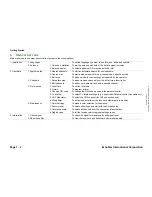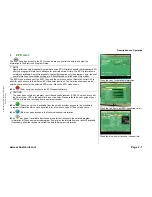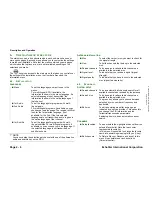
Glossary
www.echostar-int.com
Page 4 - 1
©
20
04
Ech
o
S
tar
In
te
rn
ati
o
nal
C
o
rp
or
at
io
n
Al
l ri
g
h
ts
r
e
s
e
rv
e
d
GLOSSARY
1.
A
BBREVIATIONS
AC
Alternating Current (ac voltage)
COFDM
Coded Orthogonal Frequency Division
Multiplex
DC
Direct Current (dc voltage)
DTT
Digital Terrestrial Television
DVB-T
Digital Video Broadcasting - Terrestrial
FEC
Forward Error Correction
FFT
Fast Fourier Transform
Freq
Frequency
FTA
Free-To-Air
GI
Guard Interval
LCN
Local Channel Number
MUX
Multiplex
PID
Packet Identification
QAM
Quadrature Amplitude Modulation
UHF
Ultra High Frequency
VHF
Very High Frequency
2.
T
ERMINOLOGY
Active antenna
An active antenna has a built-in pre-amplifier which means that the
received signal gets amplified before it is fed to the receiver. The
advantage of this antenna type is that (longer) antenna cables become
less vulnerable for interference. This results in better quality audio and
video.
COFDM
In the DTT area, COFDM is a form of signal transmission as specified by
DVB-T. The result of the COFDM digital transmission is to provide a
received picture that is always free of ghosts and noise (snow).
Constellation
A Constellation is a modulation scheme to improve the transmission.
Known digital frequency modulation schemes are:
QPSK means Quadrature Phase Shift Keying;
QAM16 means 16-state Quadrature Amplitude Modulation;
QAM64 means 64-state Quadrature Amplitude Modulation.
CVBS
Composite video is a combination of the three basic elements of a video
picture (color, brightness, and synchronization) into a single cable with
two wires in it as used in SCART and RCA (Video) connections.
Digital Terrestrial TV
Digital Terrestrial Television or DTT is basically a digital TV signal
received through a conventional (indoor or outdoor) TV antenna. Digital
broadcasts give you DVD-quality video and CD-quality audio.
FEC
A recover-signal mechanism which is part of the transmission that gives
the receiver software the opportunity to correct for missing or corrupted
data in the received digital signal.
FFT
A modulation mechanism which is part of the transmission used to make
the transmitted signal less vulnerable for interference.
Frequency band
A frequency band is a range of frequencies which are dedicated to a
certain usage. In the terrestrial broadcast area, commonly known bands
are the VHF-band and the UHF-band.
FTA
An unscrambled broadcast which you can view without additional
equipment and payments to a service provider.
Guard interval
A timing mechanism which is part of the transmission to prevent
distorted signals due to transmission errors and signal echoes.
Local Channel
Number
Some service providers transmit a preferred channel order to make sure
that during a channel search, all channels are re-arranged in a ‘logical’
order. If this selection is active, you are not able to move the channels
according to your personal preferences.




































